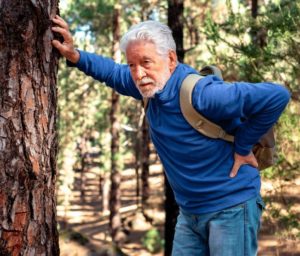 Back pain can occur at any age but individuals 50 and older are more vulnerable. Factors like degenerated or bulging discs, age-related wear and tear, arthritic joint pain and insufficient core strength can increase these risks.
Back pain can occur at any age but individuals 50 and older are more vulnerable. Factors like degenerated or bulging discs, age-related wear and tear, arthritic joint pain and insufficient core strength can increase these risks.
Is Back Pain Normal for Older Adults?
Based on spinal structure, a degree of back pain is expected with age. The spine is made up of 24 bones, each cushioned by a jelly-like disc with muscles and ligaments on either side for support. After 30, you may begin to feel the effects of age-related wear in the spine and neck joints, which only intensifies.
Your doctor may recommend imaging to diagnose the issue, followed by physical therapy to improve your posture, help you better manage pain or adapt to age-related changes.
Back pain can be a sign of something more serious, like a tumor or infection if you notice one or more of the following symptoms:
- Sudden or unexplained weight loss
- Fever
- Incontinence
- Pain that has spread, including down your legs
- Numbness or tingling in the extremities
- Greater discomfort at certain times of the day
Conditions Associated with Back Pain
Especially for older adults, back pain may be a symptom of:
- Degenerating Discs and Joints: As you age, the discs between your vertebrae lose moisture, become less responsive and shock-absorbing properties decrease. Poor posture and thinning bones can cause the disc to slip and compress a nearby nerve.
- Arthritis: Osteoarthritis can occur in the neck, spine and hip. Age-related cartilage deterioration can cause the bones of the facet joints to rub against each other and worsen degenerative disc disease.
- Sacroiliac Joint Dysfunction: This condition affects the sacroiliac joints located on both sides of the lower spine. Similar to sciatica, pain typically occurs in the lower back and hip area, usually on one side of the body, and may spread to the groin or thigh. Older adults may also experience less flexibility in this region or notice more pain as they climb stairs or bend to pick up an object.
- Spinal Stenosis and Spondylolisthesis: Typically affecting the lumbar region, spondylolisthesis occurs when a vertebra slides onto the next bone below. Spinal stenosis – when the pathway for the spine begins to narrow – can place pressure on nearby nerves, including those along the spinal cord. This combination may cause lower back pain that also radiates down one or both legs. Discomfort may intensify when using stairs and decrease when you sit. Spinal stenosis and spondylolisthesis may occur in conjunction with arthritis, a spinal cord injury, herniated disc, tumor or may be misdiagnosed as sciatica.
- Spinal Compression Fracture: Also called a vertebral or osteoporotic fracture, this condition is characterized by sudden back pain, as well as a change in position and height. You may feel pain decrease when lying down, while risks increase in response to osteoporosis and long-term corticosteroid use.
Back pain can also be a symptom of a spinal tumor, an infection or bruising of the tailbone and lower spinal column.
Treatment for Back Pain in Older Adults
For persistent back pain, you’ll undergo a physical exam and imaging. Treatment generally centers around pain management, exercise and modifying daily activities. This may entail:
- Applying ice in 20-minute increments when you experience pain or a muscle spasm.
- Applying heat to increase blood flow and flexibility in response to muscle spasms and stiffness.
- Performing one to two hours of aerobic activity per week and strength training at least twice a week. For older adults, aquatic exercise can limit stress on other joints.
- Core and lumbar stabilization to improve posture and comfort when moving, better support the spine and decrease fall injury risks.
- Physical therapy to improve stability, flexibility and strengthen core muscles.
- Taking an anti-inflammatory drug or undergoing steroid injections to manage pain.
If you’re experiencing back pain, the medical team at Avon Health Center can help you manage the symptoms. To learn more about our services, contact us today.
« How Older Adults Can Manage Extreme Cold Weather

